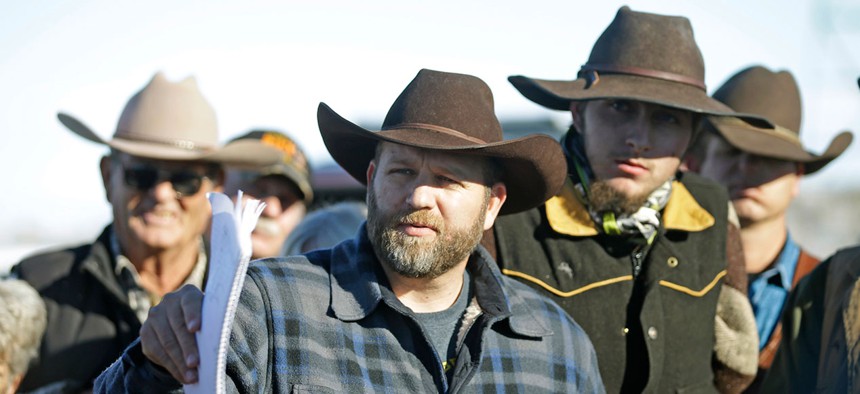
Ammon Bundy speaks with a reporter at a news conference at Malheur National Wildlife Refuge Friday. Rick Bowmer/AP
The Anti-Government Roots of the Oregon Standoff
The Bundy family is in the headlines, but the armed occupation has ties to broader movements.
Two families are getting lots of attention in the armed occupation of federal lands in Oregon.
One is the Bundy family—specifically, the sons of Cliven Bundy, the Nevada rancher who had a standoff with the Interior Department in 2014 over unpaid grazing fees. His sons, Ammon and Ryan, are leading the occupation of the Malheur National Wildlife Refuge.
The other is the Hammond family, the father-son duo of Oregon ranchers whose five-year prison terms for burning 140 acres of public lands have become a cause célèbre among antigovernment activists. They don’t, however, support takeover of the Malheur refuge.
But the situation in Oregon has much deeper roots than these families. It’s part of a wider suite of actions with ties to the far-right, antigovernment “patriot movement,” a loose confederation of groups that is divided over Ammon Bundy’s aggressive strategy, with some condemning it. At the same time, it can’t be untethered from older conflicts over the use and control of federally owned lands that comprise vast swaths of Western states.
American University professor Carolyn Gallaher is an expertin militia and paramilitary movements in the U.S. and overseas. She recently spoke with National Journal about what’s unfolding in rural Oregon, and the nexus between the patriot movement that emerged in the 1990s, tensions over land use, and how heated antigovernment rhetoric fits into U.S. election-year politics.
She and other analysts, such as the Southern Poverty Law Center, note that President Obama’s election touched off an increase in activity in far-right groups, including the patriot movement. But they also say that’s just one factor.
“We also have to think about the Great Recession, which of course coincided with his election. And in the West in particular, something that hasn’t been discussed a lot but I think is important here is the drought. When the movement talks about these new restrictions on [Bureau of Land Management] lands, some of these restrictions have to do with the drought,” Gallaher said.
More broadly, she said, domestic extremist activism is cyclical. “The resurgence of the extreme Right kind of goes in waves. It is difficult to know exactly which one of those causes is more important, but they are definitely all working in concert together,” she said.
The prosecution of the Hammonds, she said, is a logical thing for patriot activists to seize upon, even though the family itself doesn’t back the armed takeover. “The militia movement, or the patriot movement, they look and they see this and they say, ‘this is a great case to press forward our concerns about BLM lands,’” she said.
“In the West, public lands are often viewed as the commons, meaning that anyone can use it, and a lot of the sort of rhetoric or the ideology behind the patriot movement out West is that the government never really should have owned those lands in the first place—that once the frontier was opened up for settlement, and the government sort of took control of what was left, once states were carved up, the states should have gotten that land,” Gallaher said.
But Gallaher and others also emphasize that the saga of the Hammonds reflects broader collisions over how the Bureau of Land Management oversees federal lands. The agency has a mandate to balance conservation, recreation, and industrial uses including ranching and mining and drilling.
Indeed, the call by the Oregon occupiers for federal lands to be transferred to local ownership, and for greater access for activities such as logging and ranching, is consistent with the goals of conservative activists and lawmakers who aren’t part of armed extremist movements.
For instance, on Capitol Hill, lawmakers including House Natural Resources Committee Chairman Rob Bishop of Utah are part of a broader movement to transfer federal lands in the West to local ownership.
And as The New York Times reports, the goals of the Bundy-led action reflect the tenets of the conservative “wise use movement” that emerged about 30 years ago.
That movement “answers the question of who should own the West by granting moral primacy to natural resource companies and to logging and ranching families like the Bundys, some of which have worked the land since the pioneer expansion,” the Times notes. And even before that, the “Sagebrush rebellion” movement that began in the 1970s battled federal ownership and control of federal lands.
Today, the standoff in Oregon comes at a time when some GOP candidates are offering strong antigovernment rhetoric, but Gallaher said that’s it’s part of an evolution of mainstream politics.
“One thing that I began to notice in the ‘90s was that the extremist antigovernment rhetoric that was being bandied about in the patriot movement was starting to seep up into the mainstream,” she said. “I think we’ve hit a nexus at some point, or a high point, of this kind of rhetoric. But it’s not like it came out of the blue, that Ted Cruz is the first person to suggest that the federal government is engaged in tyranny.”
NEXT STORY: Two Simple Ways to Be More Mindful This Year







